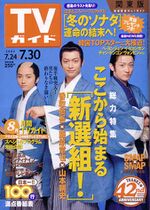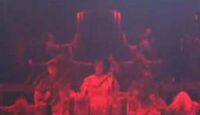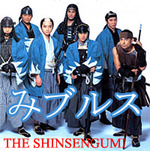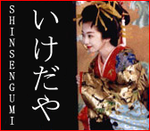Shinsengumi
“Er...kanpai?”
“Aku Soku Zan!!!! Ano Okita Souji-sama wa Gackt yori kawaii no da!!!”
The Shinsengumi are a six-member Japanese rock band. They reached their peak popularity in the mid-1800s, but retain a large fan base even today.
Prelude: The Roshigumi[edit]
The Shinsengumi got their meager beginning under the direction of Kiyokawa Heihachirou, who put together the initial band The Roshigumi. The Roshigumi lineup consisted of:
- Kiyokawa Heihachirou - guitar
- Serizawa "Goose" Kamo - drums
- Hijikata "The Demon" Toshizou - vocals and lyrics
- Saitou Hajime - bass
- Okita Souji - guitar and background vocals
- Yamanami Keisuke - keyboard
However, The Roshigumi would not last. Only two weeks after forming The Roshigumi, Kiyokawa made arrangements to move the band to Edo without consulting the other members. Angered, the band affirmed The Roshigumi's presence in Kyoto by hanging Kiyokawa upside-down from a lamppost, by the feet, with the strings from his own guitar. Yamanami took leadership of the band, changing the name to The Shinsengumi.
The Shinsengumi[edit]
With the addition of Harada Sanosuke to replace Kiyokawa on guitar, the Shinsengumi played small inns, restaurants, and temple festivals in Kyoto, where they soon caught the eye of Shogun Records producer Kondou Isami. Kondou and Yamanami quickly worked out a contract, and The Shinsengumi debuted several months later with their first full-length album "Makoto," soon followed by the Oricon-topping single "Okami."
They distinguished themselves visually from other rock groups by consistently dressing in period samurai clothing. Fans soon learned to recognize the flashy "Shinsengumi uniform", a blue haori coat with white mountain stripes. As their manager Kondou predicted, these costumes were not only easy to identify, but easy to produce, and the audience at The Shinsengumi's concerts was often a sea of light blue. (This ease of cosplay would later lead to venue security confiscating as many as 5,000 swords, knives, and spears from the audience per night.) While The Shinsengumi originally performed in full samurai garb, they soon had to relinquish armour and weapons as their attempts to crowd-surf left many audience members with stab wounds.
Nevertheless, The Shinsengumi's popularity skyrocketed, largely due to their increasingly dramatic onstage fanservice. Even today they are renowned for their mock onstage battles, choreographed by Hijikata and manager Kondou Isami, who both had watched a lot of action movies. Okita and Harada became known for their particularly bloody performances, in which Okita would vomit fake blood onto the audience while Harada cut open his stomach in a gruesomely realistic imitation of hara-kiri. This led some cities to ban The Shinsengumi from performing, but even more welcomed the band with open arms. At the behest of American fan Commodore Perry, they even crossed oceans to give several performances in England and America, writing the English-language mini-album "Regulations" for the tour.
In 1863, Serizawa Kamo died from a nori overdose. This came as quite a shock to The Shinsengumi, who had known nothing about Serizawa's addiction. Police initially suspected Yamanami, Hijikata, and Okita of foul play, for it was well-known that they considered Serizawa too reckless during interviews and thought he had a stupid name. However, no evidence was ever found linking the sheets of nori in Serizawa's rooms to any other members. The Shinsengumi remained without a drummer for nearly a year, signing on Nagakura Shinpachi just in time for their 1864 album, "Sakemotte!!"
Serizawa's death weighed heavily on Yamanami. His performance grew "increasingly crapular," according to Hijikata, and in 1864, Yamanami finally left the band to pursue a new career with rising female performer Akesato. Hijikata, who had anticipated this turn of events, quickly replaced stepped forward to fill the role of leader and replaced Yamanami with Shimada Kai on keyboard. However, this was the beginning of the end for the Shinsengumi.
The Shinsengumi's career took a bad turn in 1867 when bassist Saitou was rushed to the hospital with ramune poisoning. The band had stayed up drinking to celebrate the release of their latest single, "Floatin' Down the Tokugawa Kawa", and while the rest of the members knew of Saitou's problem, Saitou had previously managed to keep his ramune habit a secret from his fans. Okita had begun to suffer throat and lung problems from his constant use of fake blood. For three months after Saitou's ramune poisoning, Hijikata developed a severe case of both writer's block and athlete's foot which left him unable to compose lyrics. Distressed and worried by the poor health of his friends, Harada developed insomnia, which caused his concentration to suffer. When he nearly disemboweled himself for real during a performance at Edo's Bukodan, The Shinsengumi knew that their career would soon draw to a close.
The Shinsengumi managed to keep their health long enough to release three more singles, "Hey Jimmy", "Seppuku" and "Kyoto ga Moeru!" before their final album, "Ikedaya ~Saigo no Album~." They officially disbanded at the end of the tour in 1869.
- The Shinsengumi are:
- Yamanami Keisuke - keyboard (resigned)
- Hijikata "The Demon" Toshizou - vocals and lyrics
- Serizawa "Goose" Kamo - drums (died)
- Nagakura Shinpachi - drums
- Saitou Hajime - bass
- Okita Souji - guitar and background vocals
- Harada Sanosuke - guitar
Discography[edit]
Albums[edit]
- Makoto (1853)
- Miburusu (1856) [1]
- Kono Chi'iro no Ashiato (1856)
- 1860 - Regulations (English language mini-album)
- Bushido (How do you do?) [Gaijin Mix]
- Can't Leave Me Baby
- Fundz
- Litigation -NO!-
- Fight Me Private~Die Me Public
- Follow the Leader [Fight and Die Mix]
- Follow the Leader [Shibito Mix]
- Cha Yori Chi (1861)
- "Sakemotte!!" (1864)
- Shi no Isshin (1866)
- Ikedaya ~Saigo no Album~ (1869)
Singles[edit]
- Okami
- Bakufuruzu
- Tennen Rishin Ryuu
- Nishi Hongan-ji
- Bushido (How do you do?)
- Shimabara
- Follow the Leader
- Kirei na Kunoichi ga Boku no Mado no Soto ni Imasu
- Aizu Heito Yuu
- Atama ga Chiru
- Buta no Uta
- Gion Matsuri
- Floatin' Down the Tokugawa Kawa
- Hey Jimmy
- Seppuku
- Kyoto ga Moeru!
References[edit]
- ↑ While the band claims that this is a play on words reading "Mibu Blues", (Miburusu = Mibu burusu) it has also been translated as "Mibu Rules" and, by fans of rival bands, "Mibu Ruse".









